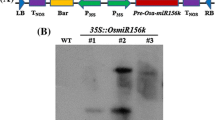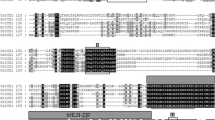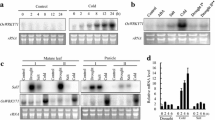Abstract
MicroRNAs may increase cold stress tolerance by regulating stress-related signal transduction pathways and by modulating the expression of transcription factors. However, the molecular mechanism by which microRNAs enhance cold stress tolerance is not fully understood. Here, we report that overexpression of rice microRNA156 (OsmiR156) results in increased cell viability and growth rate under cold stress in Arabidopsis, pine, and rice. OsmiR156 increases cold stress tolerance by targeting OsSPL3. OsSPL3 positively regulates the expression of OsWRKY71, a negative regulator of the transcription factors OsMYB2 and OsMYB3R-2. OsMYB2 counteracts cold stress by activating the expression of the stress-response genes OsLEA3, OsRab16A, and OsDREB2A. OsMYB3R-2 counteracts cold stress by activating the expression of OsKNOLLE2, OsCTP1, OsCycB1.1, OsCycB2.1, and OsCDC20.1. In OsmiR156 transgenic rice cell lines, the transcript levels of OsLEA3, OsRab16A, OsDREB2A, OsKNOLLE2, OsCTP1, OsCycB1.1, OsCycB2.1, and OsCDC20.1 were increased by OsWRKY71 knockdown and inversely regulated by OsWRKY71 overexpression, indicating that OsmiR156 enhances cold stress tolerance by regulating the expression of transcription factor genes in plant cells. These results will increase our understanding of microRNA-related cold stress tolerance in different plant species, including monocotyledonous, dicotyledonous, and gymnosperm plant species, and will be valuable in plant molecular biotechnology.






Similar content being viewed by others
Data availability
This article does not contain any large-scale data.
References
Agarwal M, Hao Y, Kapoor A, Dong CH, Fujii H, Zheng X, Zhu JK (2006) A R2R3 type MYB transcription factor is involved in the cold regulation of CBF genes and in acquired freezing tolerance. J Biol Chem 281:37636–37645
Arenhart RA, Schunemann M, Bucker Neto L, Margis R, Wang ZY, Margis-Pinheiro M (2016) Rice ASR1 and ASR5 are complementary transcription factors regulating aluminium responsive genes. Plant Cell Environ 39:645–651
Arshad M, Feyissa BA, Amyot L, Aung B, Hannoufa A (2017a) MicroRNA156 improves drought stress tolerance in alfalfa (Medicago sativa) by silencing SPL13. Plant Sci 258:122–136
Arshad M, Gruber MY, Wall K, Hannoufa A (2017b) An insight into microRNA156 role in salinity stress responses of Alfalfa. Front Plant Sci 8:356
Baek D, Chun HJ, Kang S, Shin G, Park SJ, Hong H, Kim C, Kim DH, Lee SY, Kim MC, Yun DJ (2016) A role for Arabidopsis miR399f in salt, drought, and ABA signaling. Mol Cells 39:111–118
Bartel DP (2004) MicroRNAs: genomics, biogenesis, mechanism, and function. Cell 116:281–297
Baxter HL, Mazarei M, Dumitrache A, Natzke J, Rodriguez M, Gou J, Fu C, Sykes RW, Turner GB, Davis MF, Brown S, Davison B, Wang ZY, Stewart CN Jr (2017) Transgenic miR156 switchgrass in the field: growth, recalcitrance, and rust susceptibility. Plant Biotechnol J 16:39–49
Bergonzi S, Albani MC, Ver Loren van Themaat E, Nordstrom KJ, Wang R, Schneeberger K, Moerland PD, Coupland G (2013) Mechanisms of age-dependent response to winter temperature in perennial flowering of Arabis alpina. Science 340:1094–1097
Bredow M, Vanderbeld B, Walker VK (2016) Knockdown of ice-binding proteins in Brachypodium distachyon demonstrates their role in freeze protection. PLoS One 11:e0167941
Butt HI, Yang Z, Chen E, Zhao G, Gong Q, Yang Z, Zhang X, Li F (2017) Functional characterization of cotton GaMYB62L, a novel R2R3 TF in transgenic Arabidopsis. PLoS One 12:e0170578
Carnavale Bottino M, Rosario S, Grativol C, Thiebaut F, Rojas CA, Farrineli L, Hemerly AS, Ferreira PC (2013) High-throughput sequencing of small RNA transcriptome reveals salt stress regulated microRNAs in sugarcane. PLoS One 8:e59423
Chatterjee S, Grosshans H (2009) Active turnover modulates mature microRNA activity in Caenorhabditis elegans. Nature 461:546–549
Debat HJ, Grabiele M, Aguilera PM, Bubillo RE, Otegui MB, Ducasse DA, Zapata PD, Marti DA (2014) Exploring the genes of yerba mate (Ilex paraguariensis A. St.-Hil.) by NGS and de novo transcriptome assembly. PLoS One 9:e109835
Frazier TP, Sun G, Burklew CE, Zhang B (2011) Salt and drought stresses induce the aberrant expression of microRNA genes in tobacco. Mol Biotechnol 49:159–165
Frazier TP, Burklew CE, Zhang B (2014) Titanium dioxide nanoparticles affect the growth and microRNA expression of tobacco (Nicotiana tabacum). Funct Integr Genomics 14:75–83
Gao S, Yang L, Zeng HQ, Zhou ZS, Yang ZM, Li H, Sun D, Xie F, Zhang B (2016) A cotton miRNA is involved in regulation of plant response to salt stress. Sci Rep 6:19736
Gebelin V, Argout X, Engchuan W, Pitollat B, Duan C, Montoro P, Leclercq J (2012) Identification of novel microRNAs in Hevea brasiliensis and computational prediction of their targets. BMC Plant Biol 12:18
Goff SA, Ricke D, Lan TH, Presting G, Wang R, Dunn M, Glazebrook J, Sessions A, Oeller P, Varma H (2002) A draft sequence of the rice genome (Oryza sativa L. ssp. japonica). Science 296:92–100
Hichri I, Barrieu F, Bogs J, Kappel C, Delrot S, Lauvergeat V (2011) Recent advances in the transcriptional regulation of the flavonoid biosynthetic pathway. J Exp Bot 62:2465–2483
Iglesias MJ, Terrile MC, Windels D, Lombardo MC, Bartoli CG, Vazquez F, Estelle M, Casalongue CA (2014) MiR393 regulation of auxin signaling and redox-related components during acclimation to salinity in Arabidopsis. PLoS One 9:e107678
Imtiaz M, Yang Y, Liu R, Xu Y, Khan MA, Wei Q, Gao J, Hong B (2015) Identification and functional characterization of the BBX24 promoter and gene from chrysanthemum in Arabidopsis. Plant Mol Biol 89:1–19
Jia X, Ding N, Fan W, Yan J, Gu Y, Tang X, Li R, Tang G (2015) Functional plasticity of miR165/166 in plant development revealed by small tandem target mimic. Plant Sci 233:11–21
Jian H, Wang J, Wang T, Wei L, Li J, Liu L (2016) Identification of rapeseed microRNAs involved in early stage seed germination under salt and drought stresses. Front Plant Sci 7:658
Jiao Y, Wang Y, Xue D, Wang J, Yan M, Liu G, Dong G, Zeng D, Lu Z, Zhu X, Qian Q, Li J (2010) Regulation of OsSPL14 by OsmiR156 defines ideal plant architecture in rice. Nat Genet 42:541–544
Jones-Rhoades MW, Bartel DP (2004) Computational identification of plant microRNAs and their targets, including a stress-induced miRNA. Mol Cell 14:787–799
Jung JH, Lee HJ, Ryu JY, Park CM (2016) SPL3/4/5 Integrate developmental aging and photoperiodic signals into the FT-FD module in Arabidopsis flowering. Mol Plant 9:1647–1659
Kamthan A, Chaudhuri A, Kamthan M, Datta A (2015) Small RNAs in plants: recent development and application for crop improvement. Front Plant Sci 6:208
Kim JY, Kwak KJ, Jung HJ, Lee HJ, Kang H (2010) MicroRNA402 affects seed germination of Arabidopsis thaliana under stress conditions via targeting DEMETER-LIKE Protein3 mRNA. Plant Cell Physiol 51:1079–1083
Kis A, Tholt G, Ivanics M, Varallyay E, Jenes B, Havelda Z (2016) Polycistronic artificial miRNA-mediated resistance to wheat dwarf virus in barley is highly efficient at low temperature. Mol Plant Pathol 17:427–437
Lei KJ, Lin YM, Ren J, Bai L, Miao YC, An GY, Song CP (2016) Modulation of the phosphate-deficient responses by microRNA156 and its targeted SQUAMOSA PROMOTER BINDING PROTEIN-LIKE 3 in Arabidopsis. Plant Cell Physiol 57:192–203
Li B, Byrt C, Qiu J, Baumann U, Hrmova M, Evrard A, Johnson AA, Birnbaum KD, Mayo GM, Jha D, Henderson SW, Tester M, Gilliham M, Roy SJ (2016a) Identification of a stelar-localized transport protein that facilitates root-to-shoot transfer of chloride in Arabidopsis. Plant Physiol 170:1014–1029
Li H, Dong Y, Chang J, He J, Chen H, Liu Q, Wei C, Ma J, Zhang Y, Yang J, Zhang X (2016b) High-throughput microRNA and mRNA sequencing reveals that micrornas may be involved in melatonin-mediated cold tolerance in Citrullus lanatus L. Front Plant Sci 7:1231
Lippold F, Sanchez DH, Musialak M, Schlereth A, Scheible WR, Hincha DK, Udvardi MK (2009) AtMyb41 regulates transcriptional and metabolic responses to osmotic stress in Arabidopsis. Plant Physiol 149:1761–1772
Lovdal T, Olsen KM, Slimestad R, Verheul M, Lillo C (2010) Synergetic effects of nitrogen depletion, temperature, and light on the content of phenolic compounds and gene expression in leaves of tomato. Phytochemistry 71:605–613
Ma Q, Dai X, Xu Y, Guo J, Liu Y, Chen N, Xiao J, Zhang D, Xu Z, Zhang X, Chong K (2009) Enhanced tolerance to chilling stress in OsMYB3R-2 transgenic rice is mediated by alteration in cell cycle and ectopic expression of stress genes. Plant Physiol 150:244–256
Massoumi M, Krens FA, Visser RG, De Klerk GM (2017) Azacytidine and miR156 promote rooting in adult but not in juvenile Arabidopsis tissues. J Plant Physiol 208:52–60
Mathieu J, Yant LJ, Murdter F, Kuttner F, Schmid M (2009) Repression of flowering by the miR172 target SMZ. PLoS Biol 7:e1000148
Nah G, Lee M, Kim DS, Rayburn AL, Voigt T, Lee DK (2016) Transcriptome analysis of Spartina pectinata in response to freezing stress. PLoS One 11:e0152294
Rushton PJ, Macdonald H, Huttly AK, Lazarus CM, Hooley R (1995) Members of a new family of DNA-binding proteins bind to a conserved cis-element in the promoters of α-Amy2 genes. Plant Mol Biol 29:691–702
Saha G, Park JI, Ahmed NU, Kayum MA, Kang KK, Nou IS (2016) Characterization and expression profiling of MYB transcription factors against stresses and during male organ development in Chinese cabbage (Brassica rapa ssp. pekinensis). Plant Physiol Biochem 104:200–215
Sharma N, Tripathi A, Sanan-Mishra N (2015) Profiling the expression domains of a rice-specific microRNA under stress. Front Plant Sci 6:333
Shen J, Xie K, Xiong L (2010) Global expression profiling of rice microRNAs by one-tube stem-loop reverse transcription quantitative PCR revealed important roles of microRNAs in abiotic stress responses. Mol Genet Genomics 284:477–488
Shin DH, Choi MG, Kang CS, Park CS, Choi SB, Park YI (2016) A wheat R2R3-MYB protein PURPLE PLANT1 (TaPL1) functions as a positive regulator of anthocyanin biosynthesis. Biochem Biophys Res Commun 469:686–691
Soitamo AJ, Piippo M, Allahverdiyeva Y, Battchikova N, Aro EM (2008) Light has a specific role in modulating Arabidopsis gene expression at low temperature. BMC Plant Biol 8:13
Song G, Zhang R, Zhang S, Li Y, Gao J, Han X, Chen M, Wang J, Li W, Li G (2017) Response of microRNAs to cold treatment in the young spikes of common wheat. BMC Genom 18:212
Srivastava AK, Sablok G, Hackenberg M, Deshpande U, Suprasanna P (2017) Thiourea priming enhances salt tolerance through co-ordinated regulation of microRNAs and hormones in Brassica juncea. Sci Rep 7:45490
Sunkar R, Zhu JK (2004) Novel and stress-regulated microRNAs and other small RNAs from Arabidopsis. Plant Cell 16:2001–2019
Tang W, Newton RJ (2005) Transgenic Christmas trees regenerated from Agrobacterium tumefaciens-mediated transformation of zygotic embryos using the green fluorescence protein as a reporter. Mol Breeding 16:235–246
Tang W, Page M (2013) Transcription factor AtbZIP60 regulates expression of Ca2+ -dependent protein kinase genes in transgenic cells. Mol Biol Rep 40:2723–2732
Tang W, Newton RJ, Weidner DA (2007) Genetic transformation and gene silencing mediated by multiple copies of a transgene in eastern white pine. J Exp Bot 58:545–554
Thiebaut F, Grativol C, Carnavale-Bottino M, Rojas CA, Tanurdzic M, Farinelli L, Martienssen RA, Hemerly AS, Ferreira PC (2012) Computational identification and analysis of novel sugarcane microRNAs. BMC Genom 13:290
Tombuloglu H, Kekec G, Sakcali MS, Unver T (2013) Transcriptome-wide identification of R2R3-MYB transcription factors in barley with their boron responsive expression analysis. Mol Genet Genomics 288:141–155
Vendemiatti E, Zsogon A, Silva G, de Jesus FA, Cutri L, Figueiredo CRF, Tanaka FAO, Nogueira FTS, Peres LEP (2017) Loss of type-IV glandular trichomes is a heterochronic trait in tomato and can be reverted by promoting juvenility. Plant Sci 259:35–47
Wang M, Wang Q, Zhang B (2013) Response of miRNAs and their targets to salt and drought stresses in cotton (Gossypium hirsutum L.). Gene 530:26–32
Wang Z, Wang Y, Kohalmi SE, Amyot L, Hannoufa A (2016) SQUAMOSA PROMOTER BINDING PROTEIN-LIKE 2 controls floral organ development and plant fertility by activating ASYMMETRIC LEAVES 2 in Arabidopsis thaliana. Plant Mol Biol 92:661–674
Wang J, Yu H, Xiong G, Lu Z, Jiao Y, Meng X, Liu G, Chen X, Wang Y, Li J (2017) Tissue-specific ubiquitination by IPA1 interacting Protein1 modulates IPA1 protein levels to regulate plant architecture in rice. Plant Cell 29:697–707
Xia K, Wang R, Ou X, Fang Z, Tian C, Duan J, Wang Y, Zhang M (2012) OsTIR1 and OsAFB2 downregulation via OsmiR393 overexpression leads to more tillers, early flowering and less tolerance to salt and drought in rice. PLoS One 7:e30039
Xie K, Wu C, Xiong L (2006) Genomic organization, differential expression, and interaction of SQUAMOSA promoter-binding-like transcription factor and microRNA156 in rice. Plant Physiol 142:280–293
Xie F, Wang Q, Sun R, Zhang B (2015) Deep sequencing reveals important roles of microRNAs in response to drought and salinity stress in cotton. J Exp Bot 66:789–804
Yaish MW, Sunkar R, Zheng Y, Ji B, Al-Yahyai R, Farooq SA (2015) A genome-wide identification of the miRNAome in response to salinity stress in date palm (Phoenix dactylifera L.). Front Plant Sci 6:946
Yang A, Dai X, Zhang WH (2012) A R2R3-type MYB gene, OsMYB2, is involved in salt, cold, and dehydration tolerance in rice. J Exp Bot 63:2541–2556
Yu J, Hu S, Wang J, Wong GK, Li S, Liu B, Deng Y, Dai L, Zhou Y, Zhang X et al (2002) A draft sequence of the rice genome (Oryza sativa L. ssp. indica). Science 296:79–92
Zhan X, Wang B, Li H, Liu R, Kalia RK, Zhu JK, Chinnusamy V (2012) Arabidopsis proline-rich protein important for development and abiotic stress tolerance is involved in microRNA biogenesis. Proc Natl Acad Sci USA 109:18198–18203
Zhou J, Liu M, Jiang J, Qiao G, Lin S, Li H, Xie L, Zhuo R (2012) Expression profile of miRNAs in Populus cathayana L. and Salix matsudana Koidz under salt stress. Mol Biol Rep 39:8645–8654
Zhou M, Li D, Li Z, Hu Q, Yang C, Zhu L, Luo H (2013) Constitutive expression of a miR319 gene alters plant development and enhances salt and drought tolerance in transgenic creeping bentgrass. Plant Physiol 161:1375–1391
Zhu C, Ding Y, Liu H (2011) MiR398 and plant stress responses. Physiol Plant 143:1–9
Acknowledgements
We acknowledge internal grants. We are also thankful to the central instrumentation facility of NIPGR for providing the necessary experimental setup. We thank the Council of Scientific Research and the University Commission. We further thank Dr. Prasad for support. The authors are grateful to Dr. Neale, Dr. Page, Dr. Bradshaw, Dr. Lischewski, Dr. Thompson, and Dr. Andersen-Ranberg for their critical reading and suggestions during the preparation of this manuscript.
Funding
This work was supported by a grant from the Education Committee of Hubei Providence of China and by the National Natural Science Foundation of China (31270740).
Author information
Authors and Affiliations
Contributions
WT and MZ conceived and designed the experiments. WT wrote the paper. WT and MZ performed the experiment and analyzed the data. All authors read and approved the final manuscript.
Corresponding author
Ethics declarations
Conflict of interest
The authors declare that they have no competing interests.
Ethical approval
This article does not contain any studies with human participants or animals performed by any of the authors.
Additional information
Communicated by S. Hohmann.
Rights and permissions
About this article
Cite this article
Zhou, M., Tang, W. MicroRNA156 amplifies transcription factor-associated cold stress tolerance in plant cells. Mol Genet Genomics 294, 379–393 (2019). https://doi.org/10.1007/s00438-018-1516-4
Received:
Accepted:
Published:
Issue Date:
DOI: https://doi.org/10.1007/s00438-018-1516-4




